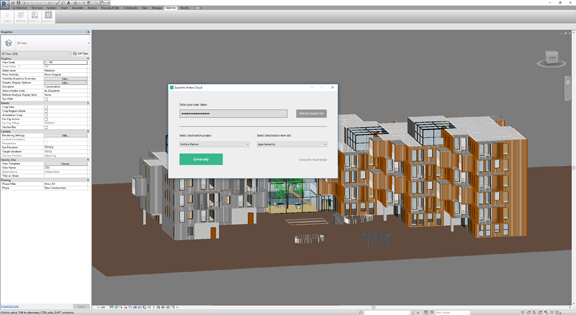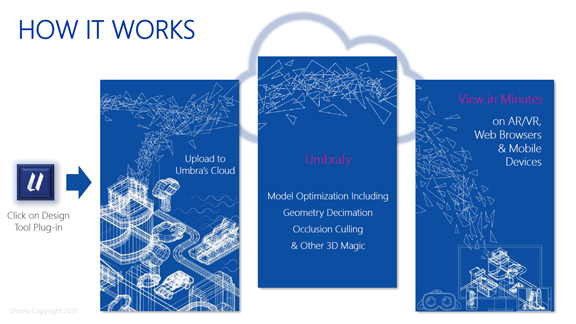
Umbrafying a Revit model into AR-VR-viewable content (image courtesy of Umbra).
October 17, 2017
With a long history in the game industry, Helsinki-based Umbra is now looking to expand into AEC, discrete manufacturing, and beyond.
In the press release issued today, Umbra CEO Otso Mäkinen said, “Umbra has spent over a decade supplying real-time, 60 frames-per-second, 3D optimization to the world’s most demanding AAA game publishers. We now bring that expertise to AEC and other industries wrestling with how to interact, revise, and view incredibly complex 3D models.”
Accordingly, Umbra today launched Composit, described as a “solution that makes it possible to display any 3D content in real-time on any piece of hardware.”
Composit’s use of the cloud to optimize and stream the 3D content promises to give AR-VR (augmented reality, virtual reality) users a cordless experience.
Umbra also plans to offer a viewer called Pryzm for licensing, aiming to serve the collaboration market.
 Umbrafying a Revit model into AR-VR-viewable content (image courtesy of Umbra).
Umbrafying a Revit model into AR-VR-viewable content (image courtesy of Umbra).The Umbra Magic
“Umbrafication,” according to Shawn Adamek, chief marketing officer at Umbra, “means to optimize complex 3D models with a single click.”
To Umbrafy something, you upload the 3D content to the Umbra Cloud. “The Umbrafication involves geometry decimation, occulsion culling, and other 3D magic,” said Adamek.
Umbra anticipates the speed and convenience with which you can iterate will make Umbra’s approach attractive to many users. With a single-click approach, the product aims to serve those with limited 3D modeling and rendering experience—such as construction engineers.
“With Umbra, you can make changes, then hit the Umbrafy button to regenerate the 3D content for a new iteration,” said Adamek. “In our tests, models with 60-70 million polygons, showing football stadiums and skyscrappers, take roughly about an hour to Umbrafy. These are extreme cases. Most models take about 10-12 mins.”
 Umbra launches Umbra Composit, which lets you convert 3D content into AR-VR viewable content (image courtesy of Umbra).
Umbra launches Umbra Composit, which lets you convert 3D content into AR-VR viewable content (image courtesy of Umbra).Discrete Manufacturing on Umbra’s Roadmap
AEC is the first market on Umbra’s list of conquest, followed by discrete manufacturing, geospatial, automotive and aerospace, and medical.
“There are some clear pain points we can immediately address with AEC,” explained Adamek. Clash and collision detection with AR-VR proves immensely useful for field engineers and construction crews, he pointed out.
The company has ironed out the conversion process from popular AEC modelers like Autodesk Revit and Graphisoft ArhiCAD to Microsoft HoloLens.
Umbra’s Composit can output WebGL-compatible content, therefore Umbra-optimized content can also be viewed with desktop, laptop, and mobile devices with WebGL-powered browsers.
Umbra’s published roadmap shows plans to support manufacturing-specific packages, such as those from SolidWorks, PTC, and Autodesk. The R&D team’s goal is to support “object metadata visualization, enabling quick viewable changes at runtime,” the company states.
Cordless AR-VR
Some AR-VR display technologies require the viewing device to be attached to a workstation or a heavy computing system, as realtime rendering of AR-VR content demands intense computational power. By contrast, Umbra’s cloud-streaming approach promises a cordless AR-VR viewing experience, which adds to its appeal.
For customers in IP-sensitive industries, Umbra plans to offer private cloud setups. This will allow some customers to keep the Umbrafication infrastructure within the company’s own IT network, ensuring no data gets passed on to the public cloud.
Umbra plans to offer both Composit and Pryzm in single seat, enterprise seat , and per-project licenses. Composit licenses are available now, with prices starting at $239 per month.
Subscribe to our FREE magazine, FREE email newsletters or both!
About the Author
Kenneth Wong is Digital Engineering’s resident blogger and senior editor. Email him at [email protected] or share your thoughts on this article at digitaleng.news/facebook.
Follow DE





